| Article ID | Journal | Published Year | Pages | File Type |
|---|---|---|---|---|
| 9200482 | Neuromuscular Disorders | 2005 | 9 Pages |
Abstract
Mutations in the genes encoding dystrophin and its associated proteins, the sarcoglycans, lead to muscular dystrophy in humans and in mouse models. In the presence of identical gene mutations, the muscular dystrophy phenotype can be highly variable. Using a mouse model of limb girdle muscular dystrophy engineered with a null allele of γ-sarcoglycan, we bred the identical γ-sarcoglycan mutation into four different genetic backgrounds. We found that the γ-sarcoglycan mutation is least severe in the129SV/J (129) strain and most severe on the DBA 2J JAX (DBA) strain using quantitative measures of Evan's blue dye uptake, as a marker of membrane permeability defects, and hydroxyproline content, as a marker of fibrosis. In addition we show that the DBA mice are most severely affected regardless of gender and age. The enhanced phenotype observed in the DBA strain was not caused by exercise as the DBA mice scored the lowest in a voluntary activity test. The milder phenotype seen in the 129SV/J and C57B6/J strains suggests that these backgrounds contain modifier loci that partially suppress the muscular dystrophy phenotype. Identification of these modifier genes and the associated pathways may lead to novel therapeutic strategies.
Keywords
Related Topics
Life Sciences
Neuroscience
Developmental Neuroscience
Authors
Ahlke Heydemann, Jill M. Huber, Alexis Demonbreun, Michele Hadhazy, Elizabeth M. McNally,
